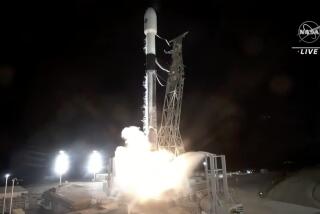Final Flight
Turn on, tune in, blast off.
The cremated remains of ‘60s icon Timothy Leary were among those rocketed into orbit Monday for the first commercial burial in outer space. The ashes of others aboard a rocket launched from the Canary Islands included those of “Star Trek” creator Gene Roddenberry, space colony advocate Gerald O’Neill and Simi Valley real estate agent James Spellman, who was the nephew of the late Cardinal Francis Spellman of Los Angeles.
In all, remains of 24 men were carried on the “Founders Flight” sponsored by Celestis, a Houston-based company created in 1994 with the expressed purpose of offering what it calls “space memorials.”
The funds for Leary’s final trip were primarily contributed by his friends Susan Sarandon, the actress, and Tony Scott, director of “Top Gun” and other films, according to Carol Rosin, a space industries consultant. Rosin said she told Leary about Celestis a few weeks before he died in Beverly Hills on May 31, 1996.
“He loved the idea that he was going to take this flight,” said Rosin, who was on hand for the launch.
“He would say, ‘Ride the light into space.’ ”
More symbolic gesture than burial, the Celestis flights are designed to carry only about a quarter-ounce of ash from each person, encased in individual aluminum capsules about the size of lipstick tubes.
The capsules, attached to the second stage of the rocket, are predicted to remain in low-flying orbit for about two to six years, Celestis officials said, before the remains are re-cremated upon reentry into the atmosphere.
The consumer cost: $4,800 per person, with a money-back guarantee if something goes wrong during a launch.
For at least this first flight, it seems Celestis will be able to keep the money.
“It was a perfect launch, right on the path,” said Celestis founder Charles Chafer, from his hotel on Grand Canary Island a few hours after the launch, which took place at about 5 a.m. Los Angeles time.
“We had to prove to the world we could do this, and now we have.”
The Celestis project was piggybacked on a flight whose primary mission was the launch of Spain’s first scientific satellite, Minisat-01.
The rocket, built by the Virginia-based Orbital Sciences Corp., was launched from underneath an L-1011 jet, which took off from the island and reached a height of about 50,000 feet before the rocket engines were fired.
“There were cameras on board, so we could actually see much of the flight as it progressed,” Chafer said.
The Celestis payload was attached to the second stage of the rocket, which fell away and moved into orbit before Minisat’s final height was reached.
Rosin, formerly a vice president at defense contractor Fairfield Industries, said watching the flight, which was broadcast live on Spanish TV, was a profound experience.
“This opens the door to all people to go into space,” she said.
Of course, they first have to be dead.
“This is just the beginning,” Rosin said, “the first hint of what’s going to happen.”
Celestis officials say one of the first people to buy a memorial flight was Majel Roddenberry, widow of the “Star Trek” creator who died in 1991. It was actually a second ride into space for his ashes--as a tribute, a bit of remains was taken along on a 1992 NASA mission.
Also on board were the ashes of O’Neill and Krafft Ehricke. O’Neill’s books on space colonization influenced a generation of dreamers. Ehricke, a rocket propulsion engineer in his native Germany during World War II, came to the United States and helped develop the liquid hydrogen propellant used on space flights.
But most of those whose ashes are now circling Earth are not celebrities. They include a Seattle dock worker, the owner of a pasta restaurant in New York, a San Francisco graphic designer and an anti-freeze salesman from Chicago.
Their short biographies, posted on the Celestis World Wide Web site, make it clear that the only thing these pioneers in death shared in life was a fascination with space flight. For each, their families or friends chose a short inscription to be etched into their capsules.
“My Final Goal Is Achieved” for the owner of a home construction company who always wanted to be an astronaut. “Live Long and Prosper” for the graphic designer who was an avid “Star Trek” fan.
Only one of the epitaphs was whimsical. Engineer Wallace Mayer’s family tells the story in his bio of his grandchild passing around T-shirts a few days after Mayer’s death. On the shirts he had printed: “Grandpa went to outer space and all I got was this lousy T-shirt.”
Mayer’s inscription reads, “Don’t forget the tee shirts, Grandpa.”
More to Read
Sign up for Essential California
The most important California stories and recommendations in your inbox every morning.
You may occasionally receive promotional content from the Los Angeles Times.











